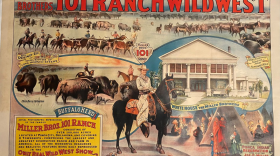In the early days of Great Plains settlement, fire was a threat. Driven by the wind, it could sweep across grasslands and crops. It might be started by lightning or human error. Fires deliberately set to burn off vegetation could get out of control.
The threat extended to settlements. With wooden buildings close together, fire could destroy a large city as easily as it could destroy a small town.
In 1893 a fire roared through Fargo. The fire quickly spread from the Little Gem Restaurant to nearby buildings. When the fire reached a gun shop, gun powder and cartridges exploded. Strong winds fanned the flames. The Fargo Argus newspaper noted, “Hell itself could not have presented a more terrible picture.” By the time the fire was extinguished, there was little left but ashes. Ninety-five percent of the city was gone.
On this date in 1905, North Dakotans learned that a former Devils Lake resident had found a way to resist the danger. A devastating fire had hit Estherville, Iowa, but the Davis Building remained standing. It was constructed of concrete blocks from the company of former North Dakotan, L.L. Bingham.
Insurance agents investigating the fire were amazed that the Davis Building withstood the heat of the fire. The water sprayed on the building froze in the winter temperatures, but the building remained unscathed. It was even undamaged after a three-story building collapsed against it. Wooden buildings erupted in flames, and brick buildings could not endure the fire and the freezing water, but the concrete blocks of the Davis Building showed almost no sign of damage.
Concrete blocks were first manufactured in America at the turn of the Twentieth Century. They were formed in wooden frames and dried like bricks. In 1900, Harmon Palmer patented a method of creating the blocks that are familiar to us today. The hollow form of the blocks retained strength while reducing weight. These concrete blocks were featured and promoted at the 1904 Louisiana Purchase Exposition, bringing them to the attention of the entire country.
Not surprisingly, insurance companies encouraged their clients to use concrete blocks for new buildings. This did a great deal to mitigate the damage of fires. And a North Dakotan had a hand in this valuable innovation.
Dakota Datebook written by Carole Butcher
Sources:
Devils Lake Inter-Ocean. “Cement Blocks Tested by Fire.” Devils Lake ND. 2/10/1905. Page 2.
The Fargo History Project. “The Fargo Fire of 1893.” http://fargohistory.com/1893-fargo-fire/ Accessed 1/12/2020.
Hall, James P. “The Early Development of the Concrete Block in America.” Master’s Thesis. Ball State University. 2009.



